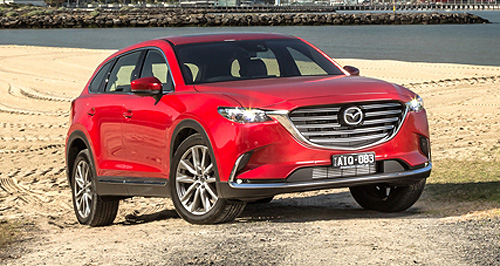Make / Model Search
News - Mazda - CX-9Mazda CX-9 designed from the inside outBig changes: Cargo space for the new-gen CX-9 has dropped compared with the outgoing model, largely due to its swoopy shape. Owners of the current Mazda CX-9 studied and interviewed to improve the breed11 Jul 2016 MAZDA’S new-generation CX-9 was designed from the inside out, with the packaging built around a wider range of occupants’ requirements more than any previous SUV offered by the Japanese car-maker. According to Mazda CX-9 chief engineer Masashi Otsuka, the aim was to create “a high-end model that is the most emotionally captivating three-row SUV”, as well as one “that truly meets the needs of the market”. With 80 per cent of global volume expected to be sold in North America, the Californian-based operations took the development lead for the first time, “because who would know better than those who live in the market and live there every day,” Mr Otsuka revealed. However, Australian input was also part of the exercise from the start of the project in 2012, to ensure that the new CX-9 met local consumer expectations. “Through this process two things became clear – that we had to win favour with families through seat comfort and easy access to the third row,” Mr Otsuka said. As a result, the CX-9 was designed and packaged around the driver, as part of the company’s “HMI Human Machine Interface” philosophy first seen in the Mazda3 small car in late 2013. This means that the seat, steering wheel, pedals, and instruments are directly straight ahead of the driver, backed up by few vision impediments thanks to reprofiled and thinner pillars and relocated exterior mirrors (from A-pillar to doors), best-possible ergonomics for all major switches and controls, clear and easy graphics, no reflections where possible, comfortable and supportive seating with deeper cushions, better contouring and no more springs to cut fatigue, sufficient ventilation and tailored noise-reducing measures. Additionally, concise control while eliminating distractions from the road ahead has brought about a centrally located and highly positioned display screen, with the main operation being via the rotary controller in the lower console, but also supported by the secondary touchscreen functionality, voice activation, a separate on/off volume dial and simplified menu-selection processes. Mr Otsuka explained that a 55mm-longer wheelbase than before (despite shorter overall dimensions) means the Mazda has larger door apertures for easier entry and egress to all rows of seating. The CX-9’s first and second row seating (including the driving position) has been designed to comfortably accommodate a wider range of people than usual for a Mazda, everything from a 50th percentile Japanese female to a 99th percentile German male. Similarly, the third row has been created to seat a pair of 170cm “American junior high school students”. Lower hip points, deeper and larger footwells, thinner seatbacks, increased under-cushion foot room and slimmer headliners help with maximising cabin space. Access to the furthest seats has been improved due to a simplified lever action that allows children to operate more easily plus, the middle seats can now be slid forward even when a baby or child seat is fitted, the result of ISOFIX latches and/or backrest-mounted hooks within the individual seat structure. Asked why the CX-9 does not have airvents in the third row, the SUV veteran – he worked on every Mazda SUV since the CX-7 of 2006 – said that heat soak and other efficiency-sapping issues relating to the underfloor piping of air to the back row would adversely affect the climate control’s performance for the front two rows, so the central vents are large in diameter. Additionally, the newcomer’s relatively swoopy silhouette and limited available headroom precluded roof-mounted outlets as found in some boxier-shaped crossover rivals. Moving to the cargo area, the tailgate is now lighter and so more child-friendly to operate thanks to a new pull-down lever, while on variants that are offered with the powered tailgate, the height can be programmed for shorter people to reach. The available space is flush for the first time when the second and third rows are folded. At 230 litres, the seven-seat luggage area is 37L less than before in five-seat mode it slides from 928L to 810L with just two seats up, there is 1641L available – a far cry from the 1911L offered in the old base version. The CX-9’s more coupe-like shape is to blame for that. Finally, Mr Otsuka said that making the CX-9 as quiet as possible became his “obsession”, and this has been achieved through the use of a thicker floorpan, 24kg of insulation between the floor and carpet instead of 7.5kg in the old CX-9, better sealing and panel gaps, and sound-absorbing acoustic glass for the windscreen and front side windows. “Mazda sought feedback from current owners,” Mr Otsuka said. “We also listened to the voices of CX-5 and CX-7 owners, as well as other sixth-generation Mazda product. We respect their views, and we found we needed to improve ride comfort and quietness performance. “So the new CX-9 reflects the global customer voice.”  Read more11th of July 2016  Mazda CX-9 engineers ‘stalked’ SUV ownersWith permission of course, as Mazda gained data observing real-world usage patterns8th of July 2016  Driven: Mazda CX-9 sales set to doubleHigher spec, lower pricing, slashed thirst to drive Mazda CX-9 demand4th of July 2016  New Mazda CX-9 a slam-dunk for safetyMazda’s CX-9 kiddie carrier breezes through ANCAP crash safety test21st of June 2016  Mazda prices CX-9 keenlyLower entry price and more variants for Mazda’s second-gen CX-9 SUV6th of April 2016  Mazda reveals fresh CX-9 detailsRange-topping Azami variant underlines Mazda’s upmarket focus for new CX-9 SUV |
Click to shareMazda articlesResearch Mazda CX-9 pricing
Motor industry news |











Facebook Twitter Instagram